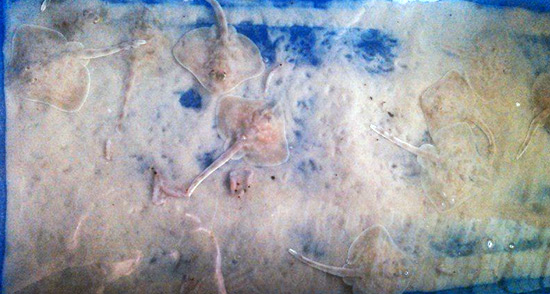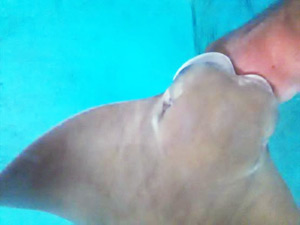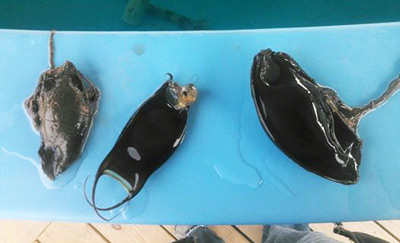From the ferocious great white shark (Carcharodon carcharias) to the graceful white-spotted eagle ray (Aetobatus narinari), Elasmobranchii are a diverse group of boneless fishes that are circumglobal, inhabiting a diverse array of habitats, temperature ranges, salinity, and niches in the world’s oceans and rivers.
It is no wonder that these unique creatures, while usually boasting comparably bland coloration to the typical teleostei reef fishes, pique the interest of pretty much every hobbyist. This group of fishes definitely has its challenges but, with proper information and species selection, can be kept fairly easily by a moderately skilled aquarist with a generous budget.
Breeding and raising elasmobranchs
You may skim over this installment of Elasmobranch Enthusiasts because your goal maybe isn’t to breed them…but you shouldn’t! Many elasmobranchs that are sold in stores are eggs or babies, and special care needs to be taken to provide the right conditions to be successful with these smaller, more delicate aquatic animals. Because it is just the beginning of our “baby” season right now, this the perfect time to talk about elasmobranch reproduction.
The birds and bees
Male and female elasmobranchs are morphologically different from each other. Males have claspers, a sex organ found on each of the pelvic fins that unfolds once inserted into the females cloaca and locks the male in place for insemination, which channels semen to the female’s cloaca. Often the male will bite his mate during copulation as well to insure the female cannot wiggle out of the embrace and potentially find a different suitor. It can be a fairly violent process!
Once fertilization occurs, depending on the elasmobranch, one of three different general types of embryonic development begins: viviparity, oviviparity, or ovoviviparity.
- Viviparity is where the baby and mother have a placental link and the embryo does not have an egg case. At birth, the young come out fairly large and fully functional in viviparous elasmobranchs.
- Oviviparity is when an egg is laid by the mother and the embryo feeds off a yolk sac for the majority of its incubation period.
- Ovoviviparity occurs when the embryo begins in an egg case with a yolk sac retained within the mother then hatches while still inside the mother and begins feeding off “uterine milk” produced by the mother. This mode of gestation encompasses all rays and produces the largest young compared to other modes.
In the aquarium, mating generally happens seasonally but can happen all year round depending on the species. Care must be taken so that the female does not get too beat up by the constant harassment of the male’s sexual urges. I suggest separating the pair after a fin gets torn or bite marks get red. White scrapes where “scales have been ruffled” on fins are often not an issue as long as water quality is good because most elasmobranchs are fairly resistant to infection when adults.
Pregnant females will generally look fairly large in their mid section in sharks, and in rays the back third of their bodies. During this time, food intake will increase and male interest will often decrease.
Knocked up!
Skates and sharks that lay egg cases generally will lay 50 or more eggs per year and will attach them to rockwork (or in my case, PVC pipe) with adhesive fibers. Or, the egg cases will have a shape that allows them to be wedged into place to secure them from getting washed ashore.
I suspend the eggs in moderate flow, or flip them frequently if left on their side, and candle them every week to ensure the embryo is growing and doing well. Always candle them submersed because the egg cases often have small holes that will leak out and expose the baby shark or skate to air, possibly suffocating them and making the egg buoyant.

Generally it takes months for an egg to hatch. Never help a shark or skate hatch; they will hatch when they are ready and hunger and lack of space drive them out. Most babies will eat after a day or two once their yolk sac is completely absorbed on their bellies. I use P.E. mysis and Superba krill for most of their meals for the first month or so. Other meaty foods can be added intermittently as they grow. Feed babies often, at a minimum of four times per day. Also supplement with Selcon and vitamins weekly.
Sharks and rays that give live birth can be tricky. I recommend having some decent space and water volume if you intend to breed an elasmobranch that gives live birth. Babies come out fairly large but stress easily in small pools/tanks. For benthic species, when you are in a pinch, a cheap kiddie pool can be used to give you a nice foot print without costing an arm and a leg. Always cover kiddie pools because elasmobranch babies jump! Almost always separate the babies from the parents. Generally, shark and ray moms will refuse food for around 24 hours to prevent consumption of the babies, but after that, I have had adults prey on babies.

When a birth occurs in a pool or tank that isn’t intended for the babies, take care in moving them. Use a large container versus a net. Generally babies will refuse food for a while after birth. I have had cownose rays refuse to feed for 10 days after they were born! To get them to eat, I scatter-feed a bunch of food in the general area of the shark or ray, and if it’s not consumed after a half hour, I siphon or net it out.
Feeding on their own tends to be a learning experience for these animals as well. Having a baby that is already feeding teach another baby to feed makes things easier on the aquarist and the baby and generally shortens the time frame between birth and first feeding.
Superba krill and P.E. mysis are my go-to favorite foods for many commonly available live birth sharks and rays, and again, a minimum of four feedings per day should be offered.
Babies should grow extremely fast in their first few months of life. If not, I would increase your feeding regimen and reassess after a couple weeks. Extra water changes are also a good idea, as babies are messy feeders and water quality can become an issue.
One of the most important things you’ll need when breeding elasmobranchs is patience. Even the fastest gestation period is around three months, and for some it is almost a year! But it is extremely rewarding to see a little ray or shark come into this world because of your great care!
See Part 1 of the Elasmobranch Enthusiasts series on aquarium space needed, Part 2 on diet and proper nutrition, and Part 3 on filtration.



